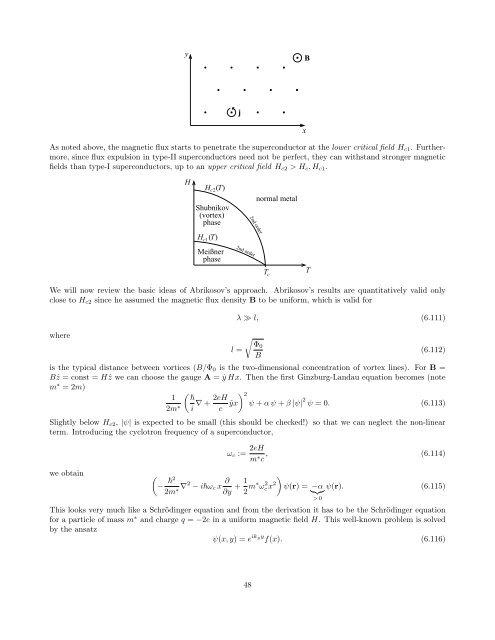Carsten Timm: Theory of superconductivity
Carsten Timm: Theory of superconductivity
Carsten Timm: Theory of superconductivity
You also want an ePaper? Increase the reach of your titles
YUMPU automatically turns print PDFs into web optimized ePapers that Google loves.
y<br />
B<br />
j<br />
As noted above, the magnetic flux starts to penetrate the superconductor at the lower critical field H c1 . Furthermore,<br />
since flux expulsion in type-II superconductors need not be perfect, they can withstand stronger magnetic<br />
fields than type-I superconductors, up to an upper critical field H c2 > H c , H c1 .<br />
x<br />
H<br />
H c2 ( T)<br />
Shubnikov<br />
(vortex)<br />
phase<br />
H c1 ( T)<br />
2nd order<br />
normal metal<br />
Meißner<br />
phase<br />
2nd order<br />
T c<br />
T<br />
We will now review the basic ideas <strong>of</strong> Abrikosov’s approach. Abrikosov’s results are quantitatively valid only<br />
close to H c2 since he assumed the magnetic flux density B to be uniform, which is valid for<br />
where<br />
λ ≫ l, (6.111)<br />
l =<br />
√<br />
Φ0<br />
B<br />
(6.112)<br />
is the typical distance between vortices (B/Φ 0 is the two-dimensional concentration <strong>of</strong> vortex lines). For B =<br />
Bẑ = const = Hẑ we can choose the gauge A = ŷ Hx. Then the first Ginzburg-Landau equation becomes (note<br />
m ∗ = 2m)<br />
(<br />
1 <br />
2m ∗ i ∇ + 2eH 2<br />
ŷx)<br />
ψ + α ψ + β |ψ| 2 ψ = 0. (6.113)<br />
c<br />
Slightly below H c2 , |ψ| is expected to be small (this should be checked!) so that we can neglect the non-linear<br />
term. Introducing the cyclotron frequency <strong>of</strong> a superconductor,<br />
ω c := 2eH<br />
m ∗ c , (6.114)<br />
we obtain (<br />
− 2<br />
2m ∗ ∇2 − iω c x ∂ ∂y + 1 )<br />
2 m∗ ωc 2 x 2 ψ(r) = −α ψ(r). (6.115)<br />
}{{}<br />
> 0<br />
This looks very much like a Schrödinger equation and from the derivation it has to be the Schrödinger equation<br />
for a particle <strong>of</strong> mass m ∗ and charge q = −2e in a uniform magnetic field H. This well-known problem is solved<br />
by the ansatz<br />
ψ(x, y) = e ik yy f(x). (6.116)<br />
48

















